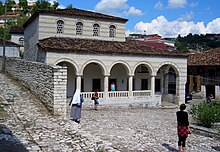Tekke
A tekke ( Ottoman تكيه tekye ; Bosnian tekija ; Albanian teqe ; Arabic زاوية zāwiya ; Persian درگاه dargāh orخانقاه chāneqāh , from the latter also transcribed Khanqah , Khaniqah or Khanqa ; pl. the Tekken) is a center of a Sufi brotherhood ( dervish order , or tariqa ) and means "place of retreat", "protection" or "asylum". There is lesstalkof a convent , because a Tekke cannot be compared with the Christian idea of a monastery.
Mainly Dhikr ceremonies take place there, with dervishes invoking God by his most beautiful names . The place can also be used for studies or other work.
Emergence
The Muslims regard the age of the Islamic prophet Mohammed as the “golden age of Islam”, in which the Muslims of that time would have lived in accordance with the laws of the still very young religion . This situation changed pretty soon after the Prophet's death, when Islam was spread through expeditions of conquest in North Africa and Asia . At that time, Islam suffered the fate of many religions and was increasingly paid lip service to the broader population.
In protest against this situation, the Sufis began to lead an ascetic way of life. There are a few reports of Muslim ascetics from the time of Muhammad, but it was only decades, if not centuries, after Muhammad's death that the Sufis began to organize themselves into ever larger orders. At that time they met in larger houses or simply outdoors in the country to hold church services together. Since these places were not protected against disturbance from outside, the first Tekken gradually emerged.
According to popular belief, the first Tekke was founded in Damascus in 150 H / 767 AD . Further foundings followed in Iraq and Khorasan before they were established throughout the Islamic world.
Different types of tekken
Tekken have different names and, in some cases, slightly different functions in the various cultural areas.
In the eastern Islamic area as well as in medieval Egypt the meeting places are called chānegāh . They were cultural and theological centers there and were mostly supported by the government. In the other cases they consisted of foundations and were run by influential benefactors.
The term zāwiya literally means “angle”. This type of meeting place is more likely to be used for smaller buildings, also called the apartment of the sheik , the head of a tekke or an order, where the dervishes meet for the dhikr. In addition, in earlier times they were often found at the crossroads of major travel routes and thus served as a resting place for the wandering dervishes. The Turks call the Sufi centers tekke or dargāh (Persian), the latter means “doorstep” or “something that is between two places”.
Building a Tekke
The architectural style of a Tekke is usually simple and undemanding. All Tekken, even the smallest, have a large main room which, depending on the Tariqa, is called sama'hane , Tevhidhane or Zikrhane . This is where the Dhikr ceremonies take place, with the Mevlevis the Sema , as well as the communal ritual prayer (Arabic: salad ).
Larger tekken often have additional rooms. For example, some have sama'hananen a separate area, Mutrib , for musicians Mutriban that the dhikr as the Mevlevi musical soundtrack.
In some Tekken there are also small living quarters for the sheikh, his wife, his daughters and younger sons. Sometimes there are also hudschras ("cells") that can be inhabited by dervishes.
Some Tekken who also work for charity have additional large rooms or even separate buildings for this purpose. An example of this is the Miskinler Tekkesi in Istanbul , which is known for its large leprosy hospital.
Within the Tekken complex there next to the sama'hana still a place called tschilachana , which serves tschila (Turkish çile exercise). For this purpose, the dervish goes into absolute seclusion for a period of 40 days in order to follow certain spiritual tasks and exercises. In the case of large Tekken, which for example represent the center of a tariqa (dervish order, community of paths), a burial site of the order's founder ( pir ) is often part of the building. This is usually a “place of visit” (Turkish Ziyaret ) of devout Muslims .
See also
Web links
- Khanqa prayer halls in Baltistan in the Tibet Encyclopaedia
Individual evidence
- ↑ Literally: "Door threshold, castle" (Junker, Alavi: Persian-German dictionary . Leipzig / Teheran 1970). The term dervish ( Persian درويش, DMG Darwīš ), "standing at the doorstep".
- ^ YN Öztürk: The Eye of the Heart . Redhouse Press, Istanbul 1988, pp. 27 .
- ↑ Annemarie Schimmel : Mystical Dimensions of Islam . Frankfurt am Main / Leipzig 1995, p. 328 .
- ^ YN Öztürk: The Eye of the Heart . Redhouse Press, Istanbul 1988, pp. 28 .
- ↑ Hz. Mevlana and the Mevlevi tariqa: Jihâdî Dede . IFI publications.

